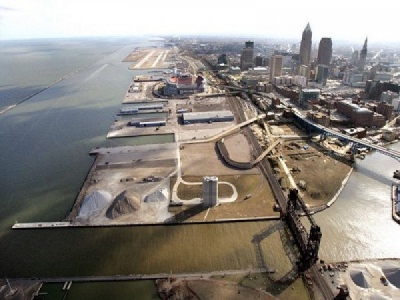
Posted on July 10, 2017
By Jane Morice, cleveland.com
An Ohio Senate bill awaiting Gov. John Kasich’s signature would give the state EPA more power to regulate dredging in Lake Erie and landfills throughout the state.
Senate Bill 2 revises environmental protection laws, putting a spotlight on Northern Ohio issues. It passed through the assembly on June 22, and Kasich is expected to sign it this week.
The Port of Cleveland and the Greater Cleveland Partnership – the state’s largest chamber of commerce – support the bill.
“GCP has long partnered with the Ohio Environmental Protection Agency and the Cleveland-Cuyahoga County Port Authority to advocate for consistent, timely dredging of the Cuyahoga River,” wrote Marty McGann, the GCP’s senior vice president for advocacy in Senate committee testimony. “Senate Bill 2 provides an enhanced regulatory framework to support these efforts, ensuring our waterways remain key attractions for quality of life, job creation and economic development.”
The bill revises laws on public water systems, Lake Erie protections and landfills and construction debris recycling sites.
See what the bill would change.
Lake Erie
Dredged materials – and how toxic they may be – have been the topic of a longstanding argument between the U.S. Army Corps of Engineers and the Ohio EPA for years.
The Army Corps has battled with state and local officials over the cost of dumping sediment from the six-mile shipping channel of the Cuyahoga River into facilities instead of placing it in Lake Erie. The state said the sediment would harm the lake’s ecosystem if it was dumped there. The Army Corps disagreed and refused to dredge unless the state paid to put the sediment into a facility.
A group that wants to release dredged materials into U.S. waters must have two permits – one from the U.S. Army Corps of Engineers and another from the state EPA.
The Ohio EPA director is currently only able to approve or deny a permit, even though on a federal level, permits can also be waived, transferred or revoked, EPA spokeswoman Heidi Griesmer said. Under the bill, the Ohio EPA director would give the state the same federal powers, Griesmer said, so it could revoke a permit if regulations were not followed.
The bill would also require the state director to create and oversee a program that would certify professionals to “assess streams and categorize wetlands” before water quality certifications are issued. However, groups that apply for a dredging permit are not required to use the water quality specialists’ services.
The bill gives even more teeth to dredging requirements by saying anyone who “purposefully” violates them a felony. And it would strengthen the Ohio Lake Erie Commission by adding members and making them a “clearinghouse for public information and data related to Lake Erie and the Lake Erie basin,” according to an analysis.
Landfill cleanup
The bill would greatly change how construction debris recycling sites are regulated by the state.
This comes about a month after the Ohio EPA announced it would spend $6 million to remove construction debris from Arco Recycling, a 6-acre illegal dump in East Cleveland.
Arco obtained the plot of land off of Noble Road in 2015 and began piling construction debris, intending to recycle it. However, the waste kept piling up, and only the minimum was recycled, the Ohio EPA said in June.
“The Arco site is the poster child for why we wanted this provision,” Griesmer said. She also called Arco a “bad actor” and said the regulations are supported by the construction and demolition debris (C&DD) industry.
The bill gives the Ohio EPA regulatory authority over debris recycling and processing facilities. It also forces the facilities to have financial assurance, meaning that if the state decided a site needed cleaned up, the company could shoulder much of the cost, Griesmer said.
Public, community water systems
The bill would require all public water systems in Ohio to show their capabilities by creating an asset management program by October 2018. The programs require specific information, including an inventory of all assets and a long-term funding strategy.
The state EPA would oversee these programs, helping smaller systems find money to upgrade, and helping guide and revise programs.
Under the new guidelines, the state director could also appoint a “receiver” of a public water system that serves fewer than 500 connections or is in such shape that it is a threat to public health.
Additionally, community water system operators would have to prove that they have the money to build onto or improve the system.
Source: cleveland.com





